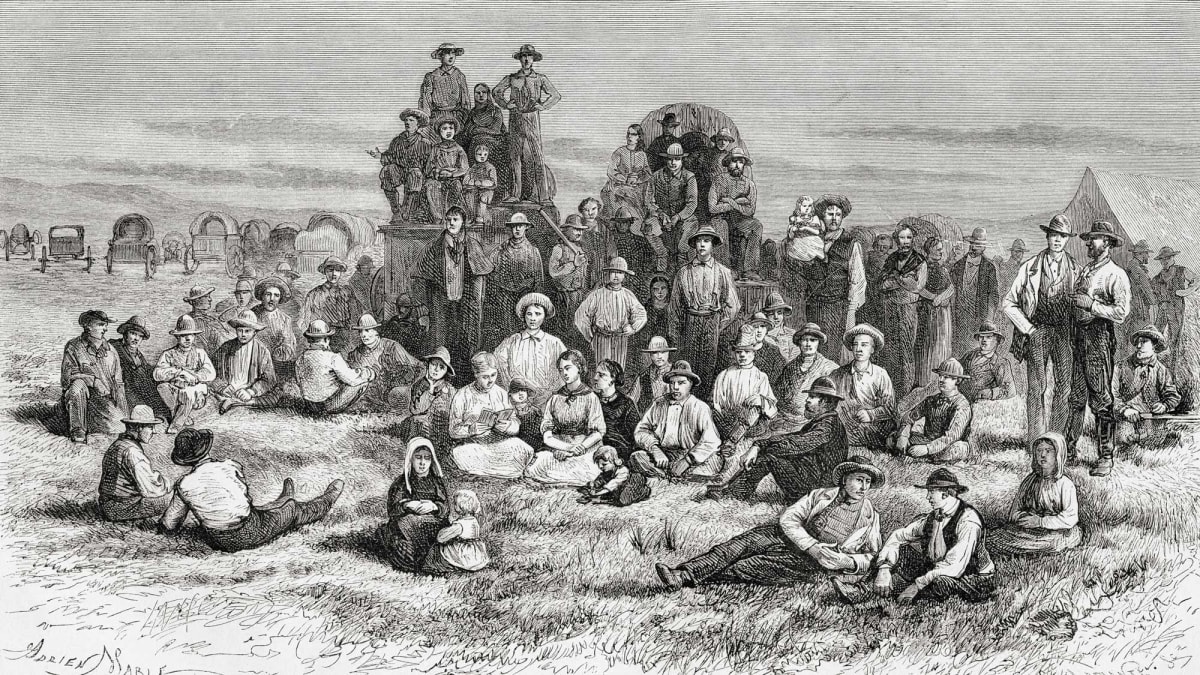
In early 1850, Church leaders advised emigrants that pioneer companies would travel on a new route on the south side of the Platte River. By taking this new route they avoided some river crossings on the north side that had proved dangerous because of high water in the previous year. They also expected to receive additional military protection on a new army supply road. This was a factor in their decision because they wanted to avoid conflict with the Plains Indians, who had been agitated during the 1849 California gold rush. The 200-mile long army road connected "Old Fort Kearny," located 50 miles below Kanesville on the Missouri River, to "New Fort Kearny" following the south side of the Platte River to the west.
Outfitted emigrants traveled 18 miles south from Kanesville on the east bank of the Missouri River to the Bethlehem Ferry (across the river from present-day Plattsmouth, Nebraska). In mid-June they began ferrying over and assembling on the west bank of the river. Wilford Woodruff called the camp together and organized the company on June 21. The next day 209 people and 44 wagons started out, following the Plattsmouth-Fort Kearny trail south. After crossing Weeping Water Creek they followed a new trail west where they connected with the northward-arching new military road, which became known as the Ox-Bow Trail.
The company was somewhat spread out with the 1st and 2nd Fifties led by Leonard Hardy and Edson Whipple. Elder Woodruff, traveling with the 1st Fifty, crossed Salt Creek on June 28. After leaving Salt Creek they turned west on a cutoff trail (near present-day Swedesburg, Nebraska). All of the companies except Andrus used this cutoff (which passed near present-day David City and Bellwood, Nebraska). This cutoff trail, which bypassed the Cottonwood/Wahoo Creek drainage, saved them 12 miles. On this shortcut route, they reached the Platte about 20 miles west of the regular route taken earlier by Andrus. During this early leg of the journey, a number of people died from cholera.
The two divisions reunited on July 7 on the Platte. They followed the south bank of the Platte River a hundred miles west past Grand Island, where they joined with the Oregon Trail coming north from Missouri. At this juncture they continued 15 more miles to "New Fort Kearny", which they reached on July 15, although army reserved grazing rights and companies weren't permitted to camp within a mile of the fort. On this day they were visited by a tremendous thunderstorm, and lightning killed three oxen and one member of the company. They continued up the south side and miraculously escaped any serious accident or wagon breakage during an exciting wagon stampede on July 30. The next day they reached the Upper Crossing of the South Platte (located about three miles west of present-day Brule, Nebraska). They finished crossing here on August 1 and followed a long dry ridge for 20 miles to Ash Hollow on the south bank of the North Platte.
From Ash Hollow they traveled up the Platte River, arriving at Fort Laramie on August 18. Leaving there, they skirted the Black Hills by taking the river road. They were delayed some days looking for lost cattle but reached the Upper Crossing (at present-day Casper, Wyoming) on September 3. Along much of the road west from Fort Laramie until they reached the Sweetwater, they found little grass, which caused their cattle to wander and slowed their pace. They reached Devil's Gate on September 8. On September 14 they bypassed the established road over the Rocky Ridges by veering to the north through a draw. This variant road, scouted out by J.A. Stratton and three other men who were sent out by Brigham Young to locate better routes and help guide the companies to the Salt Lake Valley, it reportedly had an abundance of feed and water. Unfortunately, Elder Woodruff found no feed or water and said that companies should not take that road.
They rejoined the established road just east of Rock Creek. One day west of South Pass they met with a war party of 500 Snake Indians, but were able to avoid conflict. They crossed the Green River on September 23 and reached Fort Bridger on September 27. Some in the 1st Fifty began murmuring, Elder Woodruff advised that division to move on ahead of them to the valley. Woodruff's Fifty found the road very rough between Big and Little Mountain but reached Salt Lake on October 14. Deaths in the company numbered at least 17, many from cholera.
Formed in Council Bluffs, Pottawattamie, Iowa, United States
Date Details
Occurred On 1850 June 16
Wilford Woodruff Appointed as Company Captain
Start Date Details
End Date Details
Ended On 1850 October 14
Ended in Salt Lake City, Salt Lake, Utah, United States
Date Details
Occurred On 1850 October 14
